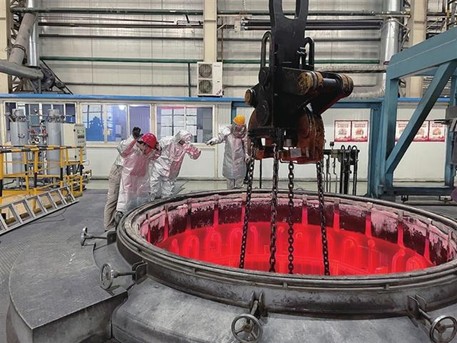In order to provide metal workpieces with the required mechanical, physical, and chemical properties, in addition to the rational selection of materials and various forming processes, heat treatment processes are often essential. Steel is the most widely used material in the mechanical industry, with a complex microstructure that can be controlled through heat treatment. Therefore, heat treatment of steel is the main content of metal heat treatment.
In addition, aluminum, copper, magnesium, titanium and their alloys can also change their mechanical, physical and chemical properties through heat treatment to obtain different performance characteristics.
Heat treatment generally does not change the shape and overall chemical composition of the workpiece, but rather imparts or improves its performance by altering the microstructure inside the workpiece or changing the chemical composition on the surface of the workpiece. Its characteristic is to improve the intrinsic quality of the workpiece, which is generally not visible to the naked eye.
The function of heat treatment is to improve the mechanical properties of materials, eliminate residual stresses, and enhance the machinability of metals. According to the different purposes of heat treatment, heat treatment processes can be divided into two categories: preliminary heat treatment and final heat treatment.
1. The purpose of preliminary heat treatment is to improve processing performance, eliminate internal stress, and prepare a good metallographic structure for final heat treatment. The heat treatment process includes annealing, normalizing, aging, quenching and tempering, etc.
l Annealing and normalizing are used for blanks that have undergone thermal processing. Carbon steel and alloy steel with a carbon content greater than 0.5% are often annealed to reduce their hardness and facilitate cutting; Carbon steel and alloy steel with a carbon content of less than 0.5% are treated with normalizing to avoid tool sticking during cutting due to their low hardness. Annealing and normalizing can refine grain size and achieve uniform microstructure, preparing for future heat treatment. Annealing and normalizing are often arranged after rough machining and before rough machining.
l Time treatment is mainly used to eliminate internal stresses generated in blank manufacturing and mechanical processing. To avoid excessive transportation workload, for parts with general precision, a time treatment can be arranged before precision machining. However, for parts with high precision requirements (such as the casing of coordinate boring machines), two or more aging treatment processes should be arranged. Simple parts generally do not require aging treatment. In addition to castings, for some precision parts with poor rigidity (such as precision screws), multiple aging treatments are often arranged between rough machining and semi precision machining to eliminate internal stresses generated during processing and stabilize the machining accuracy of the parts. Some shaft parts require time treatment after the straightening process.
l Quenching and tempering refers to high-temperature tempering treatment after quenching, which can obtain a uniform and fine tempered martensite structure, preparing for reducing deformation during surface quenching and nitriding treatment in the future. Therefore, quenching and tempering can also be used as a preparatory heat treatment. Due to the good comprehensive mechanical properties of quenched and tempered parts, some parts with low requirements for hardness and wear resistance can also be used as the final heat treatment process.
2. The purpose of final heat treatment is to improve mechanical properties such as hardness, wear resistance, and strength.
l Quenching includes surface quenching and bulk quenching. Surface quenching is widely used due to its small deformation, oxidation, and decarburization, and it also has the advantages of high external strength and good wear resistance, while maintaining good toughness and strong impact resistance internally. To improve the mechanical properties of surface quenched parts, it is often necessary to perform heat treatment such as quenching and tempering or normalizing as a preliminary heat treatment. The general process route is: cutting – forging – normalizing (annealing) – rough machining – quenching and tempering – semi precision machining – surface quenching – precision machining.
l Carburizing quenching is suitable for low carbon steel and low alloy steel. Firstly, the carbon content of the surface layer of the part is increased, and after quenching, the surface layer obtains high hardness, while the core still maintains a certain strength, high toughness, and plasticity. Carbonization can be divided into overall carburizing and local carburizing. When partially carburizing, anti-seepage measures (copper plating or plating anti-seepage materials) should be taken for the non carburizing parts. Due to the large deformation caused by carburizing and quenching, and the carburizing depth generally ranging from 0.5 to 2mm, the carburizing process is generally arranged between semi precision machining and precision machining. The general process route is: cutting forging normalizing rough and semi precision machining carburizing quenching precision machining. When the non carburized part of locally carburized parts adopts the process plan of increasing the allowance and cutting off the excess carburized layer, the process of cutting off the excess carburized layer should be arranged after carburization and before quenching.
l Nitriding treatment is a treatment method that allows nitrogen atoms to infiltrate the metal surface to obtain a layer of nitrogen-containing compounds. The nitriding layer can improve the hardness, wear resistance, fatigue strength, and corrosion resistance of the surface of the parts. Due to the low nitriding treatment temperature, small deformation, and thin nitriding layer (generally not exceeding 0.6~0.7mm), the nitriding process should be arranged as late as possible. To reduce deformation during nitriding, high-temperature tempering to relieve stress is generally required after cutting.
Post time: Oct-24-2024





